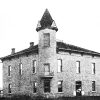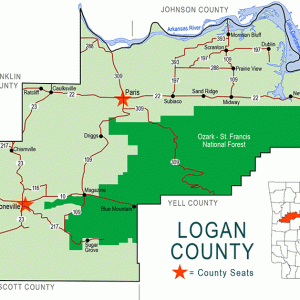calsfoundation@cals.org
Barber (Logan County)
Barber is an unincorporated community located in southwestern Logan County; it was originally in Scott County, until the county boundaries were changed in 1903. The community was established north of the Petit Jean River along Washburn Creek. Agriculture and the railroad have historically contributed to the economy and way of life in Barber. The community was likely named after a member of the Barber family who lived in the area.
Prior to European exploration, the area surrounding Barber was wilderness. Several species of wildlife that no longer inhabit the area, such as elk and buffalo, were present throughout the region. Numerous archaeological sites and burial mounds can be found along the banks of prominent waterways such as the Petit Jean River. Archaeological findings have provided evidence of early inhabitants dating to the Archaic, Woodland, and Mississippian periods. Further archaeological evidence has indicated that the people of the Caddo tribe later inhabited the area.
Spanish explorer Hernando de Soto is credited with being the first European to explore the area. One of de Soto’s proposed routes through western Arkansas potentially led him through western Logan County several miles from present-day Barber. During the late seventeenth and early eighteenth centuries, French hunters and tradesmen traveled west from the Arkansas Post, exploring portions of western Arkansas. Several rivers that flow through the region were likely named by these French explorers, including the Petit Jean, Poteau, and Fourche La Fave. It is probable that they traveled along the Petit Jean River near present-day Barber.
Settlers began arriving in the area surrounding Barber by the late 1830s. Settlers participated in a wide variety of agricultural practices, including raising livestock; farming cotton, corn, and other row crops; and planting fruit orchards.
Men called to fight in the Civil War served with both the Confederacy and the Union; the women, children, and elderly were left to look after family homes and farms. Instances of bushwhacking occurred in the area during the Civil War. During Reconstruction, many settlers traveled west to Arkansas from war-torn regions of the South in order to start a new life. Several people during this time began settling in what would become Barber.
As a result of settlement, cemeteries became a necessity. One mile north of Barber is the Hickerson Family Cemetery, located on the Hickerson farm. The cemetery was likely established circa 1870 and was used for only about twenty years.
The Barber Post Office was established soon after Reconstruction on May 13, 1878. Gabriel E. James was the first postmaster, serving for ten months. Barber was a thriving community that supported a wide variety of businesses, such as a grist mill, a barbershop, a cotton gin, a blacksmith shop, a hotel, and two saloons.
In May 1882, the Scott County Courthouse burned, destroying all records that defined the boundaries of the various school districts that had been established throughout Scott County, in which Barber was then located. Several months later, the county court reestablished the boundaries of the fifty-six school active school districts, including the Barber School District (number 49). In January 1883, C. P. Davenport petitioned the county court not to issue a liquor license within three miles of the Barber School/Church House. When the Chicago, Rock Island and Pacific Railroad was established, the school house, along with much of the community, was moved south of Washburn Creek.
On March 2, 1903, the Arkansas General Assembly changed the boundary between Scott and Logan counties, resulting in the loss of seven school districts for Scott County including the Barber School District. Barber’s post office was also transferred to Logan County. Service began on April 13, 1907, with Randolph D. Boydston as the first postmaster.
Three doctors practiced in Barber: Dr. W. W. Hornsby, a Dr. Turner, and a Dr. Head. Hornsby arrived in Barber around 1904. He established his office and drugstore in the same building that housed the post office and telephone exchange. A two-story building that housed the Odd Fellows Hall and Wilson’s Store was located on the north side of the main road. After these buildings, along with much of the town, were destroyed in a fire, many of the businesses were rebuilt.
Many railroad employees resided in Barber. Two employees operated the depot, each working an eight-hour shift. A ticket agent was employed at the depot as well.
A Baptist church was organized in Barber around 1891; however, a building was not constructed until 1905. Church services had previously been held in the Eagle Ridge School House west of Barber. The Barber church building was replaced in 1946. In 1951, church services were discontinued, and the church was remodeled as a residence.
The Barber School District was consolidated with Booneville (Logan County) in the 1940s. Economic hardships and World War II all took a toll on Barber. The community slowly declined due to the loss of businesses and the school district. The Barber Post Office closed in 1981. In the twenty-first century, only a small cluster of homes exists where the thriving town once stood.
Booneville Lake, located one mile north of Barber, became a popular recreational area for fishing, hunting, camping, boating, and picnicking. Agriculture continues to be a prominent way of life for residents still living near Barber.
For additional information:
Biographical and Historical Memoirs of Western Arkansas. Chicago: Goodspeed Publishing Company, 1891.
Cate, Michael. History of Scott County, Arkansas. Dallas: Curtis Media Corporation, 1991.
Goodner, Charles. Scott County in Retrospect. Mansfield, AR: Frank Boyd, 1976.
Goodner, Norman. A History of Scott County, Arkansas. Siloam Springs, AR: Bar D Press, 1941.
Logan County, Arkansas: Its History and Its People. Paris, AR: Logan County Historical Society, 1987.
McCutcheon, Henry Grady. History of Scott County, Arkansas. Little Rock: H. G. Pugh and Company, 1922.
Smith, Alden O. Scott County, Arkansas: Gateway to the West. Tulsa, OK: The Printing Company, 1992.
Ty Richardson
Richardson Preservation Consulting
 Logan County
Logan County Logan County Map
Logan County Map 



Comments
No comments on this entry yet.